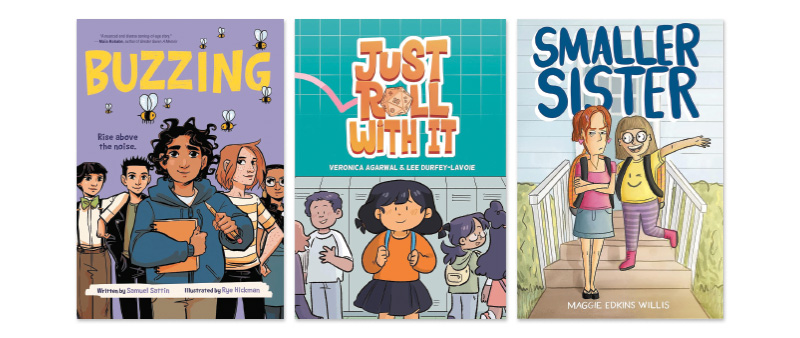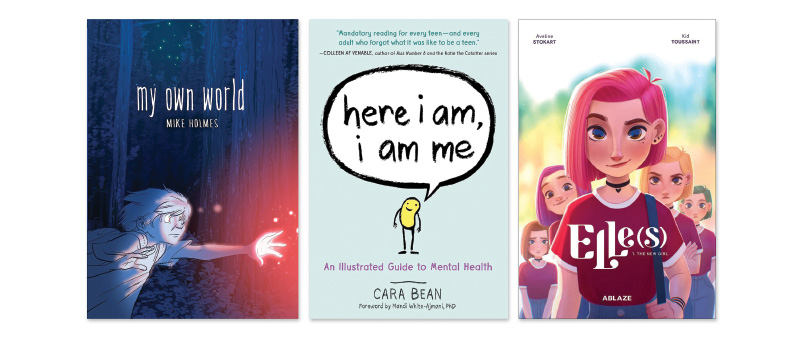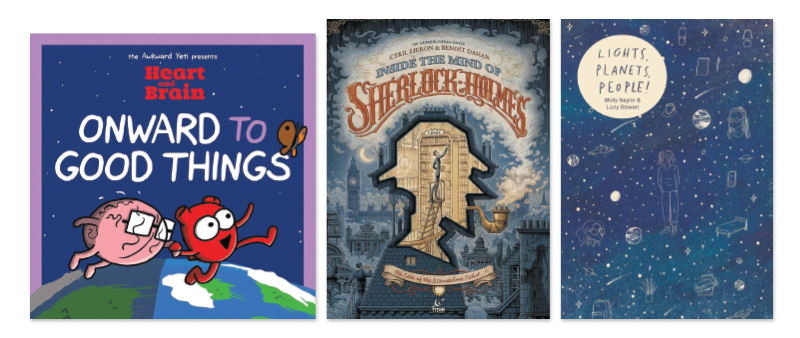Heady Stuff: Graphic Novels Get Inside Characters’ Minds
These nine works for elementary students to teenagers use visual strategies to convey inner thoughts, feelings, and emotions.
 In the series “Elle(s)” by Kid Toussaint and Aveline Stokart, the main character has dissociative identity disorder. Her hair color and facial expressions change depending on which personality is dominant. Color also conveys powerful emotion in My Own World, about an anxious boy who finds refuge in fantasy. Creator Mike Holmes uses harsh yellow-greens to depict the real world, and a softer, black-and-red palette for the imaginary realm into which his younger self escapes. At the same time, the art shifts from a craggy, realistic style to a rounder, more fantastical look.
In the series “Elle(s)” by Kid Toussaint and Aveline Stokart, the main character has dissociative identity disorder. Her hair color and facial expressions change depending on which personality is dominant. Color also conveys powerful emotion in My Own World, about an anxious boy who finds refuge in fantasy. Creator Mike Holmes uses harsh yellow-greens to depict the real world, and a softer, black-and-red palette for the imaginary realm into which his younger self escapes. At the same time, the art shifts from a craggy, realistic style to a rounder, more fantastical look.
Color is just one of the tools graphic novels use to convey complex situations at a glance and powerfully tell stories about mental health. In Buzzing, writer Samuel Sattin and artist Rye Hickman visualize their main character’s obsessive-compulsive disorder (OCD) as a swarm of bees that surrounds him, saying negative things only he can hear. When he’s feeling good, the swarm thins out; when he’s overwhelmed, it nearly engulfs him. Bees also represent OCD’s intrusive voices in the graphic novel Growing Pangs by Kathryn Ormsbee, illustrated by Molly Brooks.
Why are these illustrations so potent? Simply put, pictures pack a bigger punch than words alone. Graphic novels offer the opportunity for other cinematic techniques too, such as establishing shots, flashbacks, and voice-overs. And the fact that readers can proceed at their own pace allows for subtlety and makes tropes, such as unreliable narrators, more accessible to young readers. Here are nine graphic novels that offer different ways to see what’s happening inside someone’s head.

Sattin, Samuel. Buzzing. illus. by Rye Hickman. Little, Brown Ink. Jul. 2023. ISBN 9780316628433.
Gr 3-7–Isaac is starting at a new middle school and he falls in right away with a quirky but accepting group of friends who all play role-playing games (RPGs) together. He has also recently been diagnosed with OCD and while he’s aware of his condition and understands it, it’s still impacting his daily life. He’s surrounded by imaginary bees who constantly send him negative messages and give him orders, threatening dire consequences if he doesn’t comply. The only time they seem to go away is when he’s drawing, reading fantasy novels, or playing his RPGs. But his anxious mother is afraid that the RPGs will make his condition worse, and when his grades slip, she forbids him from participating. The bee imagery is powerful, as is the use of color: Isaac’s world is mostly gray when he is at school or at home but blossoms into full color when he is with his friends or playing games.
Durfey-Lavoie, Lee. Just Roll With It. illus. by Veronica Agarwal. Random/Graphic. Dec. 2021. ISBN 9780593125410.
Gr 4-7–As she starts sixth grade, Maggie uses little rituals to get through the day, such as greeting the house when she gets home from school and rolling a 20-sided die whenever she has to make a decision. Sometimes that gets in her way, but she fears that if she doesn’t obey the die, something terrible will happen to her family or friends. Her fears take concrete form when kids at school start talking about some sort of monster lurking outdoors. Maggie visualizes both the monster outside and her own self-doubt as dragons, with the inner dragon always ready to strike at her self-esteem whenever anything goes wrong. Maggie’s family is loving and accepting, but her worried parents want her to see a therapist, something she regards as a threat. Agarwal uses dark cross-hatching to indicate Maggie’s anxiety, sometimes putting a few wisps around the edges of the panel and other times covering her with darkness. The adults in the story deliver a few textbookish lectures about OCD, which is useful and necessary. But Maggie’s family and her best friend, Claire, also offer her some concrete strategies to help when she is overwhelmed by anxiety.
Willis, Maggie Edkins. Smaller Sister. illus. by author. Roaring Brook. Jun. 2022. ISBN 9781250767417.
Gr 4-7–This graphic novel is a perceptive take on the effect an eating disorder can have on the whole family, told from the perspective of a tween whose older sister has anorexia. Lucy and her sister, Olivia, are just 20 months apart in age and have always had a close relationship, slipping notes to each other in their secret sister code. But when Olivia reaches sixth grade, she becomes preoccupied with dieting and develops an eating disorder. Olivia isn’t the main character, though; Lucy is. The book shows her frustration as her parents become more and more preoccupied with Olivia as her sister slips further and further away. Lucy has problems of her own, and even as Olivia is recovering, Lucy begins to fall into anorexia herself. The story is fiction but is partly based on Willis’s experiences, and she writes about her family at the end of the book. The characters are well defined, with a variety of complexions and body types. In one sequence, Olivia explains body dysmorphia to Lucy with two drawings, one of her ideal body and one of how she thinks she looks, the latter nothing like the girl we see on the page.

Holmes, Mike. My Own World. illus. by author. First Second. Jun. 2021. ISBN 9781250208279.
Gr 5-8–Holmes is the artist for the Graphix adaptations of Tui T. Sutherland’s “Wings of Fire” books, but this original graphic novel is a dark, personal story of family and trauma. Nine-year-old Nathan’s world is starting to fall apart; his brother, Ben, is seriously ill and his whole family is coping with the illness in different ways. Nathan’s way is to escape into a fantasy world, one where he is in control and alone, except for anything he creates. Holmes indicates shifts between the real and the fantasy worlds by changes in palette: The outside world is green, while the fantasy realm is drawn in reds and whites that float over a dark background. At first the fantasies are a welcome escape, allowing Nathan to have total control over his little world. But as the story goes on, they become darker, until a crisis occurs and he returns to the real world where he is no longer the ruler of his realm—but is also no longer alone.
Bean, Cara. Here I Am, I Am Me: An Illustrated Guide to Mental Health. illus. by author. Workman. Apr. 2024. ISBN 9781523524389.
Gr 7 Up–Bean, an art teacher who spends her days with adolescents, leavens her relatively straightforward advice with humor and whimsical characters. The book starts out with Stigma, which she envisions as a giant, red monster that prevents people from getting help for their mental health problems. From there, she proceeds through a series of topics from the brain and depression to suicide and crisis prevention, winding up with a chapter on getting help. Bean begins each chapter with a “Question Map” that lays out topics to be covered. She approaches each one with zeal and imagination, using cartoon humans, brains, other body parts, and an array of imaginatively designed monsters to address both the emotional issues adolescents (and adults) face and the science behind causes and treatments of mental illness.
Toussaint, Kid. “Elle(s).” illus. by Aveline Stokart. Ablaze. 2022-23.
Gr 7-9–This three-volume series about a girl with dissociative identity disorder is not a clinically accurate depiction (the ending is particularly far-fetched), but it is an interesting exploration of the topic. Elle arrives at a new high school and quickly makes friends, but when stresses start piling up, the other personalities step in and her behavior, as well as her appearance, changes drastically. Stokart indicates Elle’s different personalities by changing her hair color as well as how she looks and moves. She also creates fantasy sequences where each personality has a world of her own. The story plays out in part as a struggle between pink-haired Elle, whom we meet at the beginning, and Blue, whom she keeps chained in a cell. Pink partially integrates the personalities by traveling to their worlds and liberating them, but a big reveal at the end of the story not only explains the multiple personalities, but suggests that they are a permanent part of her.

Seluk, Nick. Heart and Brain: Onward to Good Things! illus. by author. Andrews McMeel. May 2023. ISBN 9781524882228.
Gr 8 Up–This is the fourth collection of Seluk’s “Heart and Brain” webcomic, a spinoff of his “Awkward Yeti” webcomic. All you need to know is that the characters are the blue yeti’s organs, and they tend to run rogue. This volume is a wry look at everyday anxieties and dilemmas, with Heart wanting to act on every impulse and Brain overthinking everything. The other organs, including Tongue, Stomach, and Bowels, show up from time to time to complicate things. Seluk’s gentle humor is reassuring, letting the reader know they aren’t the only ones who may treat their anxiety with comfort foods, obsess over something stupid they did years ago, or get overwhelmed by emotions. In chapter introductions, Seluk talks about his life, being frank about struggles but generally striking an optimistic note. Seluk also created the children’s graphic novel The Brain Is Kind of a Big Deal . Heart and Brain is for adults, but young readers will find a lot to identify with.
Lieron, Cyril. Inside the Mind of Sherlock Holmes. illus. by Benoit Dahan. Titan Comics. Nov. 2023. ISBN 9781787738911.
Gr 9 Up–This graphic novel is about mental processes: It’s an original Sherlock Holmes story that uses maps, diagrams, numbered clues, and a depiction of the inside of Sherlock Holmes’s head as an attic stuffed with bookcases, files, and other information. Like Sir Arthur Conan Doyle’s Holmes stories, this one is set in Victorian London and features the usual cast of characters: Dr. Watson, Inspector Lestrade, and of course, Holmes’s older brother, Mycroft. The plot, about a Chinese magician who is kidnapping Londoners, is clever; and while it initially seems ethnically offensive (the magician turns out to be a former British soldier whose face was deliberately scarred to make him appear Chinese), it ends up making a powerful statement about colonialism, the Opium Wars, and marginalization of indigenous peoples. The page layouts are complicated, but the many details add up nicely and reward the careful reader.
Naylor, Molly. Lights, Planets, People! illus. by Lizzy Stewart. Avery Hill. Sept. 2021. ISBN 9781910395615.
Gr 10 Up–Adapted from a play, this graphic novel depicts astronomer Maggie Hill giving a lecture about women in science to a group of high school students. It then breaks away to show what has also been going on in Maggie’s life. She keeps her bipolar disorder a secret and has convinced herself she’s handling it well, but periods of deep depression keep her from attending the launch of the spacecraft that represents her life’s work, and isolates her from the woman she loves. The story comes out in conversations with her therapist as well as flashbacks to key moments in Maggie’s lifetime, woven back and forth with scenes of the lecture. It’s a trenchant exploration of a life filled with failures, but not devoid of hope. Stewart’s sketchy style emphasizes emotion and gesture; shifts of palette help the reader keep track of the different settings of the story as well as Maggie’s emotions.

RELATED
The job outlook in 2030: Librarians will be in demand
The job outlook in 2030: Librarians will be in demand
ALREADY A SUBSCRIBER? LOG IN
We are currently offering this content for free. Sign up now to activate your personal profile, where you can save articles for future viewing






Add Comment :-
Be the first reader to comment.
Comment Policy:
Comment should not be empty !!!